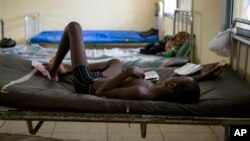The head of World Hope International says Sierra Leone has a shortage of ambulances and isolation centers, making it much more difficult to contain the Ebola outbreak. The virus has killed more than 600 people in the country.
WHI President John Lyon said the Ebola virus continues its rapid spread in Sierra Leone.
“There are about five new infections per hour there. So the rate of infection is greatly outstripping the number of beds they have to hold patients.”
He said some hospitals have ambulances, some don’t. So, people often take taxis, which contribute to the spread of the disease. WHI has donated some of its vehicles to be used as ambulances.
“You really need to have people who are trained in infection control to be able to move people who have Ebola around. That’s a major problem across the country,” he said.
Lyon said Sierra Leoneans are scared and hope the outbreak ends soon. The disease has forced them to change their behavior.
“Culturally, Sierra Leoneans are very, very friendly people. You shake hands a lot. Now, they’re conscious not to touch each other, which is also very odd for a country that’s so friendly.”
World Hope International has been asked to provide borehole water wells and sanitation facilities for the treatment centers.
Lyon said, “It’s a massive order. So we’re going to try and fill it as quickly as possible. We’ve been doing that already. We’ve been working on the Makeni hospital. Just last week we put in a submersible pump and then we’re drilling a new water well for Makeni hospital. That hospital just in the last month has had 100 cases of Ebola.”
WHI has also provided rain pavilions at Ebola checkpoints.
“They’ve set up these quarantines across the country. But alongside of the quarantines they have these Ebola checkpoints. Everybody that goes through the checkpoint has to get stopped. They have to get out of their car. Everybody gets their temperature checked that way. When the Ebola outbreak hit it was during the rainy season. We’re just now starting to come out of the rainy season. But during the rainy season everybody was having to stand out in the rain waiting for their temperature to get checked. So, we were providing some rain pavilions so that this process could take place under a dry roof,” he said.
The Sierra Leone government is conducting a massive education campaign about Ebola – something that was rarely mentioned before the outbreak. Much of that is being done through radio and going door-to-door. Recently, the government asked people to stay home for three days while 30,000 volunteers went to homes to raise awareness about the disease.
Lyon said, “That was a good campaign. It was an unusual one, but it did provide some good results. It helped the government identify where the cases are spreading the most. One of the problems in Sierra Leone is that the confidence in the medical system has collapsed so much that people are now afraid to go to Ebola centers or the hospitals to get treatment. And so what was happening was people are just staying home and not going out to get treatment. As a result they were just continuing to spread the virus further and further.”
Despite the international effort to provide medical supplies, there continues to be a huge need in Sierra Leone for such things as rubber gloves, masks and protection suits.
“It’s coming in in a rush now. So it’s coming in by the airport, coming in by the seaport. Once it gets there, we’re supporting non-profits to get it from the port to the hospitals where they need it. We have two 10-ton trucks we’re working with and a trailer. We have other smaller trucks that we’re using to get the supplies out to the places where they actually need it,” he said.
When asked how the Ebola outbreak got to this extent, Lyon blames the slow international response. The first case occurred in Guinea last December, but he says the local and international communities failed to adequately respond until July. The medical aid group Doctors Without Borders had warned last March that the outbreak had reached epidemic levels.
Also, other outbreaks, such as those in the DRC, occurred in remote, isolated areas. In West Africa, the population is much denser and more mobile.











